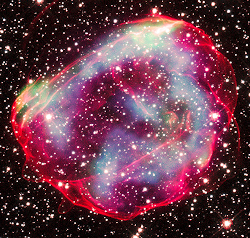 HEAPOW: A Disruptive Influence (2022 Sep 26)
HEAPOW: A Disruptive Influence (2022 Sep 26)
Supernovae explosions occur in the deep vacuum of space, but not, so to speak, in a vacuum. Although even the densest clouds in space have fewer atoms on average per cubic centimeter than even the best vacuum chambers that can be built on earth, these nebulae are large and can contain enormous amounts of matter, enough to form dozens of stars, sometimes hundreds or more. The blast wave from a star that explodes within this medium bulldozes its way into it, pushing the surrounding gas outwards from the center of the explosion. A good example is the supernova remnant, SNR 0519-69.0 (SNR 0519 for short), pictured above, a supernova which occurred in the Large Magellanic Cloud. SNR 0519 is the remnant of the explosion of a white dwarf star. This type of supernova occurs when a white dwarf accretes so much matter from a normal companion star that the white dwarf can no longer sustain itself, suddenly collapses, and ignites a thermonuclear fireball with the power of a small galaxy of stars. The image above shows a composite of optical imaging from the Hubble Space Telescope (in cyan and red) along with X-ray imaging from the Chandra X-ray Observatory (in green, blue and purple). The brightness of the X-ray emission around the remnant allows scientists to determine the overall variation in density around the explosion. Measurements suggest that density around the exploded star varies by about a factor of 10, and the faintest regions of X-ray brightness correspond to the regions with the lowest density, and vice-versa. Furthermore, comparison of images obtained over a decade or so allows scientists to study the motion of the blast wave in X-ray and optical light, and show that the fastest parts of the blast wave move at more than 10 million miles per hour. These images thus allow scientists to reconstruct how the blast from the explosion disrupts and interacts with the pre-existing material around the exploded white dwarf.
viewtopic.php?t=42632
| << Previous HEAPOW | High Energy Astrophysics Picture of the Week | Next HEAPOW >> |